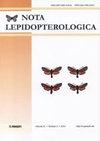The ant associates of Lycaenidae butterfly caterpillars – revisited
IF 0.7
4区 农林科学
Q4 ENTOMOLOGY
引用次数: 9
Abstract
Based on a global compilation of data on ant associates of 523 Lycaenidae species, a synthesis is attempted as to which ants participate in these interactions. Ants from 63 genera have thus far been observed as visitors of facultative myrmecophiles or as hosts of obligate myrmecophiles among the Lycaenidae. Over 98% of records come from nectarivorous and trophobiotic ants in just three subfamilies, viz. Formicinae, Myrmicinae and Dolichoderinae, with the genera Crematogaster and Camponotus occupying the top ranks. Accumulation analysis suggests that rather few ant genera remain to be added to the list of associates. The representation of ant genera as attendants of lycaenid immatures is related to their global species richness, but with some notable exceptions. Ants that form ecologically dominant, large, long-lived colonies are over-represented as hosts of obligate myrmecophiles. The taxonomic diversity of lycaenid-ant associations is highest in the Oriental and Australian region, and lowest in the Neotropical and Afrotropical region. Among tropical African lycaenids, this is due to two butterfly lineages (genus Lepidochrysops and subfamily Aphnaeinae) that have massively radiated in the Neogene, but mostly maintaining their general affiliations with either Camponotus or Crematogaster ants, respectively. Many tropical and subtropical lycaenids nowadays form associations also with invasive alien tramp ants, giving rise to novel mutualistic interactions.蝶蛾科蝴蝶毛虫的蚂蚁伙伴——再访
基于523种石首鱼科蚂蚁伙伴的全球数据汇编,试图综合哪些蚂蚁参与了这些相互作用。到目前为止,已经观察到来自63个属的蚂蚁是石首鱼科中兼性亲蝇类的访客或专性亲蝇的宿主。超过98%的记录来自蚁亚科、Myrmicinae和Dolichoderinae三个亚科中的食蜜和恐营养蚂蚁,其中Crematoaster属和Camponotus属位居榜首。累积分析表明,仍有相当少的蚂蚁属被添加到亲缘关系列表中。蚂蚁属作为石首鱼未成熟生物的附属品与它们的全球物种丰富度有关,但也有一些明显的例外。形成生态优势、大型、长寿群体的蚂蚁被过度描述为专性亲蚁类的宿主。石首鱼-蚂蚁群落的分类多样性在东方和澳大利亚地区最高,在新热带和非洲地区最低。在热带非洲石首蝶中,这是由于两个蝴蝶谱系(鳞翅目石首蝶属和Aphnaenaae亚科)在新第三纪有着巨大的辐射,但大多分别与Camponotus或Crematoaster蚂蚁保持着普遍的亲缘关系。如今,许多热带和亚热带的石首鱼也与入侵的外来流浪蚂蚁形成了联系,产生了新的互惠互动。
本文章由计算机程序翻译,如有差异,请以英文原文为准。
求助全文
约1分钟内获得全文
求助全文
来源期刊

Nota Lepidopterologica
Agricultural and Biological Sciences-Insect Science
CiteScore
1.70
自引率
14.30%
发文量
20
审稿时长
14 weeks
期刊介绍:
Nota Lepidopterologica is the scientific, peer-reviewed journal of the Societas Europaea Lepidopterologica (SEL). It publishes original contributions to the study of mainly but not exclusively Palaearctic Lepidoptera, especially on taxonomy, morphology/anatomy, phylogenetics, biogeography, ecology, behaviour, and conservation, but also on any other aspects of lepidopterology.
All articles are published in English, with the possibility of having the summary written in other languages. All submitted manuscripts are subject to peer-review by the leading specialists for the respective topic. The journal is published in open access high-resolution PDF, semantically enriched HTML and machine-readable XML versions.
All papers can be freely copied, downloaded, printed and distributed at no charge. Authors and readers are thus encouraged to post the pdf files of published papers on homepages or elsewhere to expedite distribution. Publication is free for the SEL members and there is no charge for color.
 求助内容:
求助内容: 应助结果提醒方式:
应助结果提醒方式:


